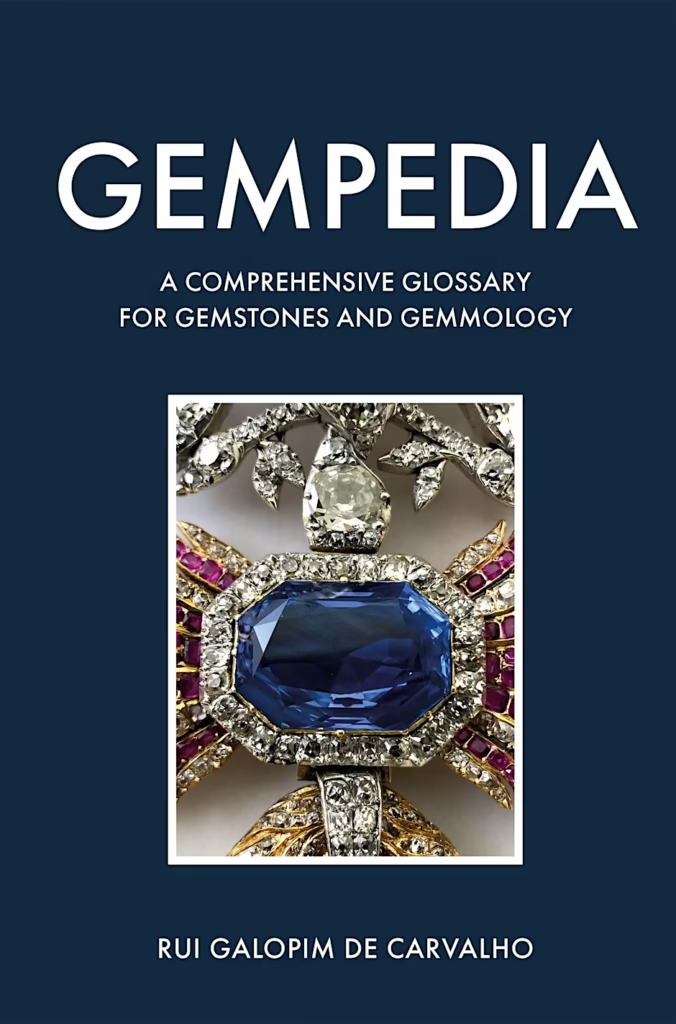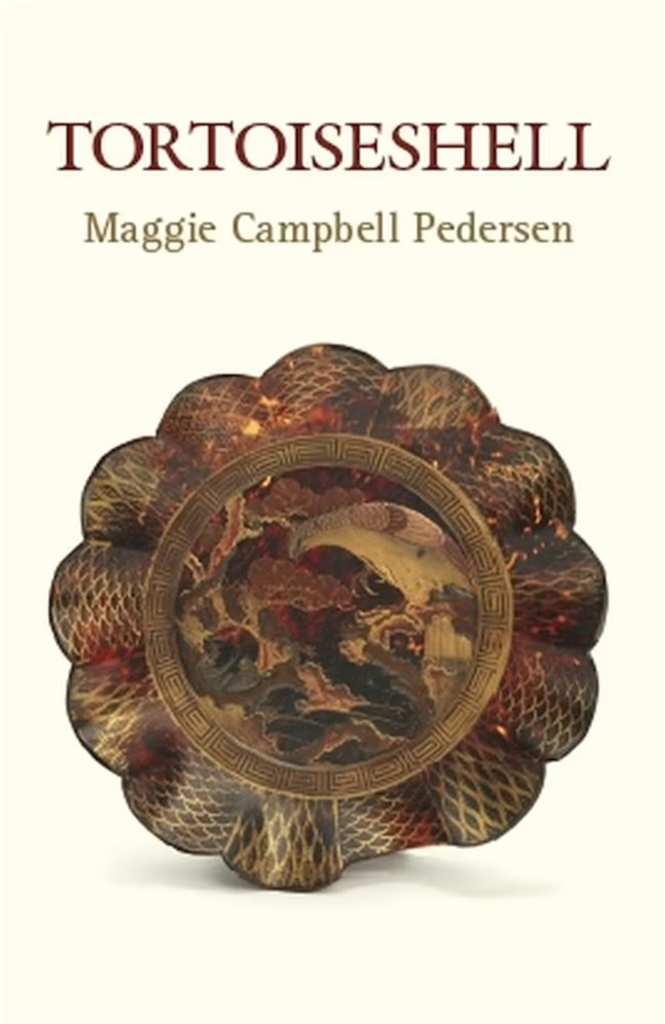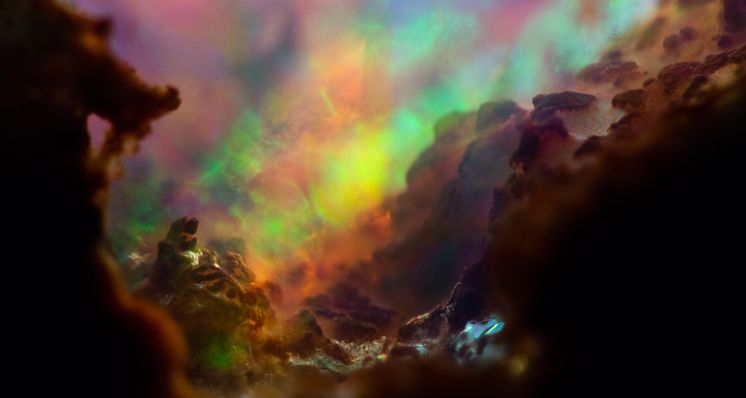
Award-winning photographer Danny Sanchez GG, a speaker at the 2016 Gem-A Conference, reveals the secrets of photomicrography, the equipment he swears by and his favourite gemstones to photograph.
Q. What drew you towards photomicrography?
I was a working musician in Los Angeles and wanted a change of pace. I’d always loved gems and minerals and when I discovered that you could study them, their origins and applications, at the Gemological Institute of America, I couldn’t enrol quickly enough. The day I opened the course material and saw an inclusion photomicrograph, I was hooked.
Q. What special equipment do you use?
I might be a little biased so I feel like a lot of my equipment is special. I think my most unusual piece of equipment is a vertical stepping rig that moves the microscope mere microns at a time.

Danny Sanchez’ home ‘laboratory’
Q. Can you explain stacking for those that don’t know?
Microscopy deals in very narrow focal planes. A single photo has very little that is actually ‘in focus’. Focus stacking is a technique that allows one to merge multiple photos, each with different focal planes, into a single photo with greater depth of field. This is stacking. Using this technique, one is able to ‘manufacture’ depth. There is definitely a way to overuse stacking. Besides the visual residue that can be found in some photo ‘stacks’ (a group of photos merged into one), if a photo is rendered with too much depth, the viewer can lose perspective. Simply put, but somewhat counterintuitively, a photo with too much depth can look flat.


Left: A single photomicrograph play of colour in opal from Jalisco, Mexico. Field of view 3.05 mm. Right: The complete stack of 81 photos. Field of view 3.05 mm
Q. Do you look at images from earlier and wish you could retake some of the spectacular ones to add the ‘dimension’ it offers?
I definitely understand the impulse to go back and re-do a shot, but it’s not a strong one for me. I’m always trying to look forward, and to reproduce or re-tool an image I’ve already made seems like a step backward — particularly in light of how many dynamic subjects this industry offers. (For more information on stacking see Prince, N., ‘Use of Stacking Software for Expanding Depth-of-Field in Inclusion Photomicrography’, The Journal of Gemmology, 2014, 34(3), 188–89).
Q. Do you have any advice for gemmologists wishing to try photomicrography at home?
There are an overwhelming number of details to consider when trying to take a successful photograph through the microscope, and it’s hard to see the forest for the trees. The simplest recommendation I can make is: buy more light than is necessary. Gemmologists are used to using a specific type and amount of light during observation and imagine that will be sufficient when they sit down to take a photograph. It never is. Light is everything in photography; it’s even more important in photomicrography.
Q. Do you have any particular favourite inclusions or gemstones to photograph?
This past year I’ve immersed myself in opal with matrix. I have yet to find a mineral more dynamic that so readily yields actual landscapes. Part of what I look for in my own work is the feeling of being transported somewhere ‘other’. I enjoy the challenge of finding that in quartz or corundum, but when I work with opal in matrix, it’s almost like the photo takes itself.
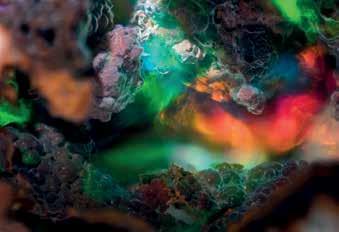
Q. How do the public react to your photos?
Most (non-gemmological) people don’t know what they’re looking at when standing in front of my photos. Once I tell them that it’s a photo of the inside of a gemstone, more often than not, they don’t believe me. Finally, when they do, they have a million questions. It’s really great to see people so invigorated about gems and minerals. I’m sure they’re much more interested when they leave than before they arrived.

Ilmenite and hematite in orthoclase feldspar from Harts Range, Australia. Field of view 3.05 mm
Q. How do you source the stones that you work with?
Mostly, I’ll buy at trade shows, looking through dealers’ back stock inventory — stones that, for one reason or another, have been passed over. Part of the joy of my process is these little discoveries and bringing something out of them that no one could have imagined. There’s something about owning the stones I work with (and hopefully producing an image from them) that makes the final product that much more satisfying. I’m not sure I can satisfactorily articulate why. Maybe, like every other gemmologist, I just like to hoard stones.
Q. Do you see your photos as an educational tool or as an art form?
Art is an inherently selfish act and mine is certainly no exception. All I ever wanted was to capture in my images a sense of mystery and wonder. It is purely self-serving and in this regard, it’s very ‘artsy’. But when people look at my images and discover that they are photos of actual minerals inside other minerals, there is an immediate spark of curiosity. The moment that happens, my photos become educational.
Q. How long does it take you to capture the ‘magic’ shot?
I’ll sit down with a parcel of stones and spend hours turning them over in my hands, changing the lighting environment, trying my best to disappear into the process. Once I’ve decided on which stone I’ll pursue, it could take another hour or so to test shoot dozens of lighting environments. The shooting and processing of a stack of 100 or more photos takes another 30 to 40 minutes. The real work happens over the following several days while I digitally develop the photo, just as I would if I were working in a traditional darkroom.

Metal sulphide in fluorite, from Elmwood, Tennessee. Field of view 1.8 mm
Q. What’s the most frustrating thing about photomicrography?
The most frustrating thing is that I can’t do it for a living. My photos don’t have to be perfect, but they have to be representative of the view through my oculars, at the same time capturing the feeling of the moment of discovery. If I don’t feel I’ve done that after I’ve gone through the process of taking the shot(s) and developing the stack, it can be very frustrating.
Q. What are your future plans for your work?
Most of my work for the past few years has focused on atmosphere, the space within the stone and not any particular inclusion or the capturing of inclusions. That’s what interests me the most and that’s what I see myself pursuing; capturing and creating the space within gems.
Q. If fleeing a burning building, what equipment do you grab?
Luckily for me, I’m not a photographer in the traditional sense of the word. I didn’t grow up aspiring to take photos nor did my penchant for gadgetry lean in that direction. My entry into the world of ‘prosumer’ cameras and lenses began with photomicrography. Because of this, I don’t have a collection of lenses or cameras that would make it hard to choose if fleeing a burning building. My most crucial pieces of equipment fit into one small hard case. I’m definitely fortunate in that regard.
Q. Your studio improvisations suggest you have a good eye for engineering solutions to suit your needs…
Everything I have done, I’ve done on the shoulders of others. Of course, I’d like to think of myself as a tinkerer and problem solver but most of my equipment has existed in some form, on someone else’s desk, in someone else’s setup. It wasn’t easy piecing it all together but with help from a very small handful of people from around the globe, I’ve put together something that I’m really proud of.
Q. Another big part of the job these days is software; how do you select the software you use?
I’ve mentioned the stacking software and while that’s a tricky nuanced piece of software, it performs one function and is therefore finite in its ability to affect a photograph. Beyond that there is developing software such as Lightroom and Photoshop. Together, they can be used to alter an image in infinite ways. While they are indispensable tools, I try to remain as faithful to the view through my oculars as possible.
Q. What are the ‘frontiers’ to be explored in photomicrography?
I think the frontiers of photomicrography lay in the direction of software. We’re so lucky to be living in a time of amazing advances, in what computers can do to aid in our perception of the world around us. One day I hope to be able to pop on a pair of VR glasses and take a flight through a Kashmir sapphire or Mexican opal.
Q. Do you have any gemmological heroes?
Of course, Eduard Gübelin and John Koivula. Without their work, who knows where I’d be.
Q. Who first encouraged you to be a photographer?
In 2007, a year or so after I bought my first microscope, I was working at a trade show and was introduced to Edward Boehm. I already knew who he was, both in the trade and his family’s importance in gemmology. I shook his hand and told him, with no small amount of youthful hubris, that I was going to be a photomicrographer. He flashed me that great smile and told me to go for it. Every subsequent time I ran into him, he would always ask how it was going and if I’d made any progress with my photos. I was the smallest blip in his periphery but for the next five years he never forgot to ask about my photos. During that time I struggled with the pursuit itself and a lot of self-doubt. It wasn’t until 2013 that I was proud enough of my work to share it with the general public. His polite consideration was such a small gesture but it made me think: if this great gemmologist, grandson of the man who helped pioneer this field, hasn’t forgotten about me and my pursuit, I can’t forget either. ■
To view more of Danny Sanchez’s work click here or visit his Instagram @mineralien
This article originally appeared in Gems&Jewellery May/June 2016 / Volume 25 / No. 3 pp. 10-12
Interested in finding out more about gemmology? Sign-up to one of Gem-A’s courses or workshops.
If you would like to subscribe to Gems&Jewellery and The Journal of Gemmology please visit Membership.
Cover image Opal, from Jalisco, Mexico. Field of view 3.05 mm. All images courtesy of Danny Sanchez.
{module Blog Articles Widget}
